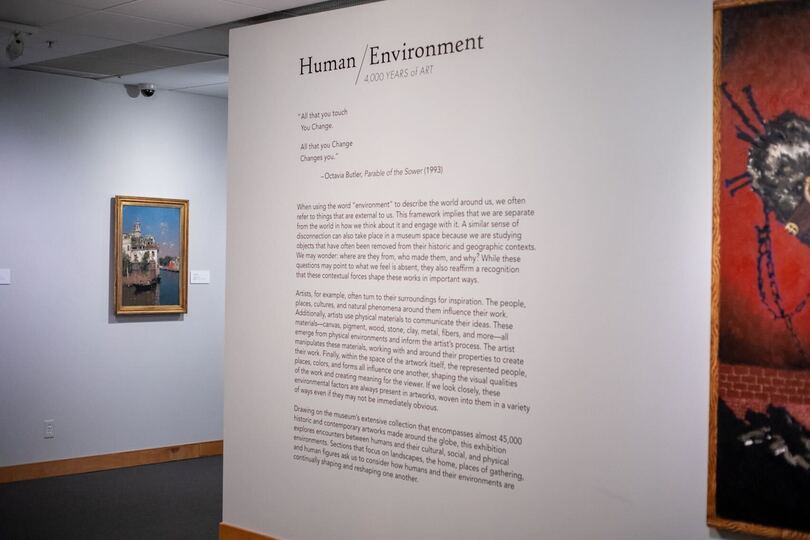‘4,000 Years of Art’ accentuates symbiotic link between history, humanity

"Human/Environment: 4,000 Years of Art" explores how people across cultures and centuries have interacted with their environments. The art exhibit will remain open for the next four academic years. Christan Calabrese | Asst. Photo Editor
Get the latest Syracuse news delivered right to your inbox.
Subscribe to our newsletter here.
Thousands of ancient sculptures, abstract art and contemporary paintings fill the Syracuse University Art Museum gallery, displaying stories that stretch across millennia. Pieces are diverse; modern prints stand next to ancient ceramics and textiles.
“The goal of this installation is to really think about how we can bring all of these different objects together in conversation,” Melissa Yuen, the exhibit’s curator, said.
The art exhibit “Human/Environment: 4,000 Years of Art” invites visitors to explore how people across cultures and centuries have interacted with and reshaped the environments they call home. It opened on Aug. 26 and will remain open for the next four academic years.
Yuen said that for this installation, she decided to focus on the inner relationship between humans and our environments. She wants visitors to think broadly about how humans shape the environment, and how their surrounding environment also shapes who they are.
It’s a symbiotic relationship, she said. Humans aren’t separate from our environment, Yuen said. This exhibit is split into thematic sections: plants, home, population centers and human figures. Yuen hopes the exhibit encourages students to reflect on how we shape our surroundings and how our environment influences us.
“4,000 Years of Art” includes a vast collection of ancient sculptures and contemporary art installations, aiming to show the geographic and temporal scope of the museum’s collection, Yuen said. She said she wants students to understand the richness of their collection and the range of objects they steward at the museum.
Each piece stands on its own, but together they have conversations across time, using the way each artist chooses to see and interpret the world, sophomore Jaishva Bhatt said. He loves how they represent snapshots of the world at different times across history.
“They’re communicating their goal of creating a depiction of the world with a nuanced appreciation for the different contexts and cultures that exist,” Bhatt said.
“Ishtar,” an ancient clay statue, is the oldest piece of art in the collection. Originating from ancient Mesopotamia around 2100–1500 BCE, the sculpture depicts the Mesopotamian goddess of the same name, who’s worshipped for love, fertility and war.
The exhibit also includes more recent art, like the painting “Spring, Villa Borghese” by Morton Kaish. The 1971 oil painting depicts the Villa Borghese, a park in northern Rome. Yuen said she hopes students can understand more about their own environments from studying paintings like this.

“Spring, Villa Borghese” by Morton Kaish is one of the more recent pieces in the “Human/Environment: 4,000 Years of Art” exhibit. The 1971 oil painting is meant to teach students about their own interactions with the environment, the curator said. Christan Calabrese | Asst. Photo Editor
“(I want students) thinking about how artists across time and space have really looked to their surroundings as one aspect or one facet for their inspiration,” Yuen said.
Each piece feels like a fragment of a much larger story, coming together to form complex ideas, SU sophomore Tai Comiso said. Visitors aren’t just visiting object to object, they’re moving through different layers of culture, time and perspective from artists, he said. He called the exhibit “a kaleidoscope” of cultures.
ESF students Abyss Mortimer and Aleise Guild hadn’t been planning to visit the museum that day. They said they were just walking by and decided to explore. They appreciated the realistic paintings they saw in this exhibit compared to the more abstract works of art they saw in the others.
Asha Comiso, Tai’s younger sister, came to the exhibit with him while she was visiting campus with their mom. She said she appreciated seeing different mediums all in one room. You get to see all different perspectives of the world, Asha said.
Mortimer and Guild explored all the current exhibits in the SU Art Museum during their visit. “4000 Years of Art” was their favorite.
“We freaking loved this one,” Mortimer said.





